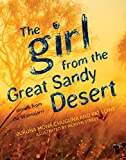
Title
The Girl from the Great Sandy Desert
Author
Jukuna Mona Chuguna
Secondary Authors
Pat Lowe
Illustrators
Mervyn Street
Publisher, Date
Magabala Books, 2015
Audience
Primary, Secondary, Upper Primary
ISBN
9781922142054
Language
English with some Walmajarri words
Add to Favourites
-
Subjects
- Daily life
- Desert
- Desert animals
- Families
- Family
- Glossaries and vocabularies
- Great Sandy Desert (WA SE51, SF51)
- Hunting and gathering
- Walmajarri / Walmatjarri people (A66) (WA SE51-16)
-
Annotation
This is a collection of semi-autobiographical stories from the childhood of Jukuna Mona Chuguna, a Walmajarri woman who grew up in the Great Sandy Desert. Jukuna told the stories in Kriolised English to Pat Lowe, who then re-wrote them into English for publication.
When Jukuna was a child, the Walmajarri people still had very little contact with Europeans, and lived a traditional life in their home country. These stories, accompanied by black and white illustrations, provide a fascinating insight into an almost pre-contact life. Each story is an episode in the lives of Jukuna and her family as they move through their country from waterhole to waterhole. Their life is not easy – sometimes there is no water, sometimes people get sick or injured and very little can be done for them. But the family all care for one another, and food is shared with everyone.
The stories are interspersed with cultural information boxes, giving context to the events being described. There is also a map at the beginning and a description of the Walmajarri people, and a list of Jukuna’s family and their interrelationships. Pat Lowe has written a useful introduction explaining how this book came to be. At the end of the book is a Walmajarri glossary and pronunciation guide.
Mervyn Street is a Gooniyandi artist, from the Fitzroy River region of northern Western Australia. In his youth he worked as a stockman and later developed his artistic talents, producing many paintings, drawings and prints of station life. (Magabala Books website)
Pat Lowe, an Englishwoman, wanted to settle in Western Australia. She moved to Broome, then in 1986, went to live in a desert camp with Jukuna’s uncle, Jimmy Pike, where she came to know Jukuna and her family. Later in life, when both Pat and Jukuna were living in Broome, they worked together to record Jukuna’s stories.
This book was longlisted in the 2016 Children’s Book Council of Australia Book of the Year Awards, for the Eve Pownall Award for Information Books.
-
Teaching Resources
- Magabala Books, [n.d.], Teacher Notes by Christina Wheeler: ‘The Girl from the Great Sandy Desert’ https://cdn.shopify.com/s/files/1/0092/5043/9268/files/The_Girl_from_the_Great_Sandy_Desert_Teacher_Notes.pdf?2403
- Reading Australia, [n.d.], Teacher Notes: ‘The Girl from the Great Sandy Desert’ https://readingaustralia.com.au/books/girl-great-sandy-desert/
- ABC Education [n.d.], Taming the Australian Desert: Locate Chapter 5: Taming the Australian Desert https://education.abc.net.au/home#!/digibook/1587973/taming-the-australian-desert
